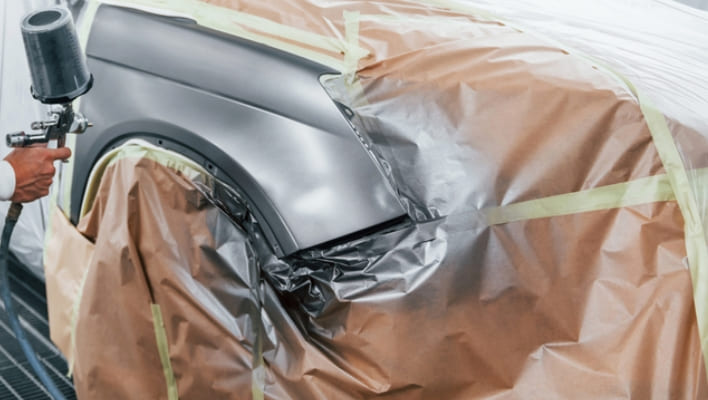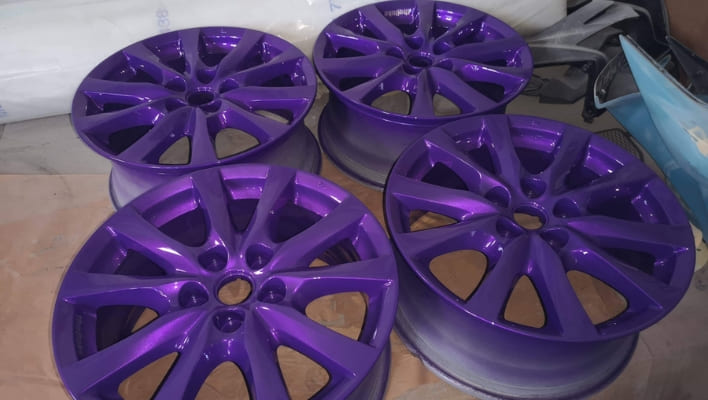Glass windows do give a modern vibe, but sometimes they look plain. You may paint them to make them look unique and pretty. But how do you do that? The start is always confusing. You might wonder what material you can use, which paint is most suitable and how to do it.
This article will discuss how to paint glass windows and the different glass paints available. Also, we will share our top recommendations for the best glass window paints so that it is easy for you to select the perfect paint for your DIY project.

Table of Contents
- what paint to use on glass windows?
- 1. Tempera Glass Paints
- 2. Acrylic Glass Paint
- 3. Acrylic Enamel Paint
- 4. Solvent-based Glass Paints
- Step-by-Step Guide On How To Paint Glass Windows
- 1. Gather Your Materials
- 2. Prepare the Painting Surface
- 3. Position Stencils & Tape
- 4. Apply the Paint
- 5. Dry and cure the Paint
- 6. Clean and hang your Artwork
- Our Top Picks for Best Glass Window Paints in 2023
- 1. MAGICDO Stained Glass Paint
- 2. MAKER’S STUDIO Ceramic Glass Paint
- Why do people paint window glass?
- How to paint glass windows to look like wood?
- How do you permanently paint on glass?
- What is painting on glass called?
- What paint to use on glass that will wash off?
- How do you get paint to stick to glass?
- Does painting windows last?
- How well does acrylic paint stay on glass?
- Wrap Up On how to paint windows permanent Or Temporary
- Martina Hitchcock
what paint to use on glass windows?
Glass indeed features a non-porous surface, emphasizing the importance of using paint specially formulated for glass. People often use oil-based and water-latex paints, but they are unsuitable for glass windows because they don’t adhere to the surface.
You will find various types of glass paint with different finishes and effects on the glass window. So, choosing the right paint that ensures longevity and great end results is important.
| Paint Type | Drying Time | Finish | Permanence |
| Washable Paint | Quick drying, within minutes | Matte | Temporary |
| Tempera Paint | Rapid drying, within 20 minutes | Matte | Temporary |
| Spray Paint | Quick drying varies by type | Translucent or opaque | Variable |
| Chalk Paint | Quick drying, within hours | Matte, chalky finish | Semi-permanent |
| Acrylic Paint | Dry within 5 to 24 hours | Opaque, matte, gloss, frosted | Semi-permanent |
| Solvent-Based Paint | Dry within 2 to 8 hours | Transparent or opaque, matte, gloss & frosted | Permanent |
| Epoxy Resin | A day to dry & a week to cure | Transparent, gloss & frosted | Permanent |
| Food-Safe Paint | Variable drying time | Non-toxic, safe for serving | Permanent |
1. Tempera Glass Paints
These paints are used on glass windows and have temporary effects. It is a type of thin, water-based paint that dries rapidly. Tempera paints have a matte finish and are often used for washable window art, such as seasonal decorations for Christmas or Halloween.
2. Acrylic Glass Paint
Acrylic water-based paint provides a non-toxic and semi-permanent choice for decorating glass windows. They adhere to the surface effectively, and you don’t need to apply a primer while using them. Acrylic paints can stay a few months longer than tempera paints.
Note: Curious about age restrictions for spray paint purchases? You can find detailed information in our dedicated article!
3. Acrylic Enamel Paint
It is a solvent-based glass paint that is used to paint glass windows permanently. These paints are oil-based and give great durability in different weather conditions (even in cold weather). Acrylic enamel paints can come in transparent and opaque varieties, offering glossy and frosted glass colors.
You can also mix them to create custom colors and they are typically applied with a soft brush. However, they produce toxic and flammable fumes.
4. Solvent-based Glass Paints
Solvent-based paints, often used for permanent glass painting projects, are oil-based and offer a rich, glossy finish, creating a beautiful stained-glass effect on glass surfaces exposed to the elements. However, these paints tend to be more expensive, toxic, and flammable, making them suitable mainly for experienced users and not recommended for children or enclosed spaces due to safety concerns. Cleanup requires solvents rather than soap and water.
Last week, I have painted wasted glass bottles with solvent based paint as you can see in the picture below.

Step-by-Step Guide On How To Paint Glass Windows
1. Gather Your Materials
After you select the paint you choose, gather these items before you paint your glass window.
- Paint brushes and sponges
- Paper towels
- Gloves
- Painter’s tape
- Scissors
- Dish soap
- Rubbing alcohol
- Razor blade
- White vinegar
2. Prepare the Painting Surface
Now, prepare the painting surface properly. Begin the cleaning process by wiping down the glass with a solution of dish soap and water.This step ensures that the glass is free of dust and grease. Then, rub alcohol to clean the glass and remove any remaining residue. Allow it to dry.
3. Position Stencils & Tape
Now put tape or stencils in their places. Stencils will be helpful assistants in making your vision come to life. You can place them on the glass’s opposite side or on the side you plan to paint. Ensure the stencils or tape are firmly secured to the glass. It will help to prevent accidental smudging or creating uneven lines in your artwork.
Pro Tip: When working with stencils, use applicator sponges to achieve flawless, thin coats of paint. Beware that sponges can absorb more paint than you might expect.
4. Apply the Paint
Now, let’s wear gloves and apply paint. Start in the upper corner rather than the edges of the tape if you’re using it as a guide. Apply a thin, even coat of paint, especially in the case of acrylic paint, as it can appear uneven if applied too thickly. Allow the paint to dry between colors. It could reduce the risk of them blending.
If spray paint is used, be cautious not to saturate the glass too much to prevent drips. After you’ve finished painting, make sure to remove the tape while the paint is still in its wet state.
Painting Hack: Use natural brushes with soft, pliable bristles to avoid visible brush strokes on your glass artwork.
5. Dry and cure the Paint
Allow the painted glass to air dry completely. Some paints, such as acrylics, benefit from a sealant. Apply a thin layer, allow it to dry thoroughly, and repeat this process with two to three additional coats. This sealing process helps the paint cure.
Some paints require baking to cure. So, make sure you preheat the oven to 350 degrees Fahrenheit and only insert the glass when the oven is hot enough to prevent the risk of cracking.
6. Clean and hang your Artwork
Before hanging the painted glass, make sure it’s clean. To clean the surface, use dish soap, water, or white vinegar followed by drying it with a paper towel.
After your painted artwork is clean and dry, find a suitable window frame to hang it. If you’re painting windows that need to be washable, consider using washable window paint or dishwasher-safe Mod-Podge for easy maintenance.
Our Top Picks for Best Glass Window Paints in 2023
Now, let’s explore some of the best glass window paints recommendations.
1. MAGICDO Stained Glass Paint
MAGICDO Glass Paint is my favorite acrylic glass paint. I used it to fill in the edges of the window film because there was minor shrinkage. The colors were perfect. I have also used it for costume jewelry like pins, earrings etc.
Pros
- It is good for regular use because of its durable and scratch-resistant nature.
- MAGICDO is safe to use as it is non-toxic and solvent-free.
- The odorless feature is a big plus because I can focus on my art without distracting or unpleasant smells.
- The UV-resistant property of this paint helps to block sun exposure.
Cons
- The paint does have a thin consistency. So, you had to add multiple layers for more vivid colors.
2. MAKER’S STUDIO Ceramic Glass Paint
This is permanent glass window paint. I used it on a cheese board; overall, it gives a positive painting experience.
Pros
- One thing that caught me by surprise was how fast this paint dries.
- Another pro is that it doesn’t need to be baked in the oven to set fully. This saves me time and effort a lot.
- Once fully cured, the ceramic paint is microwave-safe.
Cons
- Ceramic paint is not dishwasher safe.
Why do people paint window glass?

Painting glass windows can serve various purposes, both practical and aesthetic. Here are some reasons why people choose to paint glass windows:
- Privacy Enhancement: Painting windows can obscure the view from outside, providing increased privacy for the occupants of a building. This is especially valuable for bathrooms or ground-level windows facing busy streets.
- Sunlight Control: Window paint can reduce glare and the harmful effects of UV rays, making indoor spaces more comfortable and protecting furniture from fading.
- Energy Efficiency: Some window paints are designed to improve energy efficiency. They act as an additional insulating layer, helping to keep interiors cooler in the summer and warmer in the winter.
- Security and Safety: Opaque or frosted window paint can deter potential intruders by preventing them from seeing inside the building.
- Branding and Signage: In commercial settings, window painting can be used for branding, advertising, or displaying business hours. It’s a cost-effective way to attract attention and promote a business.
- Artistic Expression: Glass window painting is a form of artistic expression that allows artists to create unique and visually appealing designs. It’s often used in churches, museums, and historic buildings. Here are the glass painting ideas for beginners.
- Maintenance and Repair: Painting windows can help conceal imperfections or damage to the glass.
- Temporary Decorations: Window paint is easily removable, making it a popular choice for temporary decorations, such as holiday window displays or seasonal themes for storefronts.
- Community Engagement: Painting glass windows can foster a sense of community engagement and creativity. Public art projects often involve painting windows as a way to beautify urban spaces.
How to paint glass windows to look like wood?
To achieve a wood-grain effect on glass windows, start by applying a base coat of brown or tan acrylic enamel paint. Once dry, use a fine brush to add wood grain lines with darker and lighter shades of brown. After that, seal the paint with a clear varnish or sealer to protect the finish.
How do you permanently paint on glass?
For permanent glass painting, use enamel or glass paint designed for long-lasting adherence. Clean the glass surface thoroughly, apply the paint in thin layers, and bake it according to the paint manufacturer’s instructions. This process will make the design durable and resistant to washing or scratching.
What is painting on glass called?
Painting on glass is often referred to as “glass painting” or “glass art.” Artists and hobbyists use various techniques, including stained glass, reverse painting, and glass fusion, to create beautiful and lasting artwork on glass surfaces.
What paint to use on glass that will wash off?
You can use washable tempera or watercolor paints for creating easily removable designs on glass. These water-based options can be effortlessly cleaned off with water and a gentle scrubbing, making them ideal for temporary decorations on windows or glassware during special occasions.
How do you get paint to stick to glass?
Begin with a clean, dust-free, and oil-free glass surface to ensure paint sticks to glass effectively. Employ acrylic enamel paint specially formulated for glass surfaces. Prior to painting, apply a glass-specific primer, then use thin, even paint coats. Dry each layer completely between applications. For added durability, follow the paint manufacturer’s instructions and bake the glass in an oven.
Does painting windows last?
The longevity of painted windows varies depending on paint type and proper preparation. Well-executed glass painting using high-quality materials can endure for many years without significant fading or chipping. Regular cleaning and maintenance further extend the lifespan of painted glass surfaces.
How well does acrylic paint stay on glass?
While acrylic paint can adhere well to glass surfaces, its durability can fluctuate. To enhance permanence, choose acrylic enamel paint designed for glass applications. Adequate surface preparation, application of multiple thin coats, and following any baking instructions provided by the manufacturer can help acrylic paint adhere better and last longer on glass. Nevertheless, it may still require more care and maintenance compared to other glass painting techniques like stained glass or fused glass.
Wrap Up On how to paint windows permanent Or Temporary
Painting glass windows is a fun and artistic task. It allows you to add color and style to your living spaces. With the right knowledge and steps to paint glass windows, you can confidently tackle glass painting.
Therefore, express your artistic side and try different designs to add color to your home’s old glass windows.

Martina Hitchcock
Martina Hitchcock is a versatile author with expertise in different fields. As a paint sprayer expert, she has in-depth knowledge of paint spraying techniques, tools, and equipment. Martina is also an experienced home remodeler who has worked on various projects, including kitchen and bathroom renovations, flooring installations, and room additions. Her knowledge of home improvement and remodeling is extensive, and she enjoys sharing her insights and tips with readers. You can follow her on Facebook.


